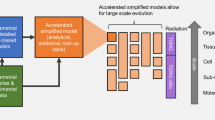Abstract
Existing computer models of cancer focus mostly on disease progression rather than its remission/recurrence caused by anti-cancer therapy. Herein, we present a discrete model of tumor evolution in 3D, based on the Particle Automata Model (PAM) that allows for following the spatio-temporal dynamics of a small neoplasm (millimeters in diameter) under treatment. We confront the 3D model with its simplified 0D version. We demonstrate that the spatial factors such as the vascularization density, absent in the structureless 0D cancer models, can critically influence the results of treatment. We discuss briefly the role of computer simulations in personalized anti-cancer therapy.
Access this chapter
Tax calculation will be finalised at checkout
Purchases are for personal use only
Similar content being viewed by others
References
American Cancer Society: Lifetime Risk of Developing or Dying From Cancer (2018). https://www.cancer.org/cancer/cancer-basics/lifetime-probability-of-developing-or-dying-from-cancer.html
Bender, J., Koschier, D.: Divergence-free smoothed particle hydrodynamics. In: Proceedings of ACM SIGGRAPH/EUROGRAPHICS Symposium on Computer Animation (SCA) (2015)
Benzekry, S., Lamont, C., Beheshti, A., Tracz, A., Ebos, J.M.L., Hlatky, L.: Classical mathematical models for description and prediction of experimental tumor growth. PLoS Comput. Biol. 10(8), e1003800 (2014)
Chabner, B.A., Longo, D.L.: Cancer Chemotherapy and Biotherapy: Principles and Practice. Lippincott Williams and Wilkins, Philadelphia (2011)
Csilléry, K., Blum, M.G., Gaggiotti, O.E., François, O.: Approximate Bayesian computation (ABC) in practice. Trends Ecol. Evol. 25(7), 410–418 (2010)
Cristini, V., Lowengrub, J.: Multiscale Modeling of Cancer: An Integrated Experimental and Mathematical Modeling Approach, p. 278. Cambridge University Press, Cambridge (2010)
Dzwinel, W., Kłusek, A., Wcisło, R., Panuszewska, M., Topa, P.: Continuous and discrete models of melanoma progression simulated in multi-GPU environment. In: Wyrzykowski, R., Dongarra, J., Deelman, E., Karczewski, K. (eds.) PPAM 2017. LNCS, vol. 10777, pp. 505–518. Springer, Cham (2018). https://doi.org/10.1007/978-3-319-78024-5_44
Dzwinel, W., Wcisło, R., Yuen, D.A., Miller, S.: PAM: particle automata in modeling of multi-scale biological systems. ACM Trans. Model. Comput. Simul. 26(3), 1–21 (2016). Article no. 20
Dzwinel, W., Yuen, D.A.: Rayleigh-Taylor instability in the mesoscale modeled by dissipative particle dynamics. Int. J. Mod. Phys. C 12(1), 91–118 (2001)
Gerlee, P., Anderson, A.R.A.: Diffusion-limited tumour growth: simulations and analysis. Math. Biosci. Eng. 7(2), 385–400 (2010)
Huang, D., et al.: Anti-angiogenesis or pro-angiogenesis for cancer treatment: focus on drug distribution. Int. J. Clin. Exp. Med. 8(6), 8369 (2015)
Iwasa, Y., Michor, F.: Evolutionary dynamics of intratumor heterogeneity. PLoS ONE 6(3), e17866 (2011)
Jagiella, N., Rickert, D., Theis, F.J., Hasenauer, J.: Parallelization and high-performance computing enables automated statistical inference of multi-scale models. Cell Syst. 4(2), 194–206 (2017)
Kaina, B.: DNA damage-triggered apoptosis: critical role of DNA repair, double-strand breaks, cell proliferation and signaling. Biochem. Pharmacol. 66(8), 1547–1554 (2003)
Kim, M., Gillies, R.J., Rejniak, K.A.: Current advances in mathematical modeling of anti-cancer drug penetration into tumor tissues. Front. Oncol. 3, 278 (2013)
Louzoun, Y., Xue, C., Lesinski, G.B., Friedman, A.: A mathematical model for pancreatic cancer growth and treatments. J. Theor. Biol. 351, 74–82 (2014)
Łazarz, R.: Graph-based framework for 3-D vascular dynamics simulation. Procedia Comput. Sci. 101, 415–423 (2016)
Masunaga, S.I., Ono, K., Hori, H., Suzuki, M., Kinashi, Y., Takagaki, M.: Potentially lethal damage repair by total and quiescent tumor cells following various DNA-damaging treatments. Radiat. Med. 17(4), 259–264 (1999)
Ribba, B., Holford, N.H., Magni, P.: A review of mixed-effects models of tumor growth and effects of anticancer drug treatment used in population analysis. CPT Pharmacomet. Syst. Pharmacol. 3, e113 (2014)
Ribba, B., Holford, N.H., Magni, P., Trocóniz, I., Gueorguieva, I., Girard, P.: A review of mixed-effects models of tumor growth and effects of anticancer drug treatment used in population analysis. CPT: Pharmacomet. Syst. Pharmacol. 3(5), 1–10 (2014)
Ribba, B., et al.: A tumor growth inhibition model for low-grade glioma treated with chemotherapy or radiotherapy. Clin. Cancer Res. 18(18), 5071–5080 (2012)
Rieger, H., Fredrich, T., Welter, M.: Eur. Phys. J. 131, 31 (2016)
Wcisło, R., Dzwinel, W., Yuen, D.A., Dudek, A.Z.: A 3-D model of tumor progression based on complex automata driven by particle dynamics. J. Mol. Model. 15(12), 1517 (2009)
Wodarz, D., Komarova, N.L.: Dynamics of Cancer: Mathematical Foundations of Oncology, p. 532. World Scientific, Singapore (2014)
Xie, H., Jiao, Y., Fan, Q., Hai, M., Yang, J., Hu, Z., et al.: Modeling Three-dimensional Invasive Solid Tumor Growth in Heterogeneous Microenvironment under Chemotherapy (2018). arXiv preprint arXiv:1803.02953
Acknowledgments
The work has been supported by the Polish National Science Center (NCN), in the scope of two projects: 2013/10/M/ST6/00531 (RW and BM) and 2016/21/B /ST6/01539 (MP and WD). We thank Piotr Pedrycz, (MSc student), for providing us with the results of parameters adaptation for 0-D tumor model.
Author information
Authors and Affiliations
Corresponding author
Editor information
Editors and Affiliations
Rights and permissions
Copyright information
© 2018 Springer Nature Switzerland AG
About this paper
Cite this paper
Panuszewska, M., Minch, B., Wcisło, R., Dzwinel, W. (2018). PAM: Discrete 3-D Model of Tumor Dynamics in the Presence of Anti-tumor Treatment. In: Mauri, G., El Yacoubi, S., Dennunzio, A., Nishinari, K., Manzoni, L. (eds) Cellular Automata. ACRI 2018. Lecture Notes in Computer Science(), vol 11115. Springer, Cham. https://doi.org/10.1007/978-3-319-99813-8_4
Download citation
DOI: https://doi.org/10.1007/978-3-319-99813-8_4
Published:
Publisher Name: Springer, Cham
Print ISBN: 978-3-319-99812-1
Online ISBN: 978-3-319-99813-8
eBook Packages: Computer ScienceComputer Science (R0)




